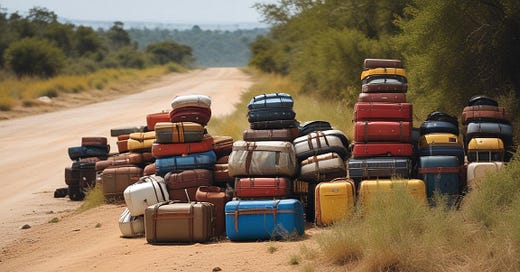We Do Therapy: Getting Back on the Freeway!
Therapy Lesson #3: Recognizing the Signs of Off-Roading
In the introductory posts to this weekly, We Do Therapy series (available to paid subscribers). Scott and I shared both the struggles and triumphs of two young adults who believed they had found someone who would care for them. Our intent in the initial posts and this series of Therapy Lessons is not to offer marriage advice. We are not licensed therapists. We are survivors who hope that what we share about our journey together will help others to be curious about how trauma might be impacting their marriage. Hopefully, far sooner than we did! (Please read the statement at the end of this post.)
Therapy Lesson #3: Recognizing the Signs of Off-Roading
Walking back into the living room after a meeting, I was ready to continue the conversation Scott and I were having before I had to hop onto Zoom. I don’t remember what I said, but I quickly realized Scott was off-roading.
I also go off-roading. It is a normal part of the messy process of healing. We have done a lot of work to become somewhat proficient in knowing what off-roading feels and looks like, but it is generally easier to recognize in each other than in ourselves. This causes a problem because it is difficult to get grounded (regulated) when we don’t realize we are ungrounded. This often results in blaming our partners for the problem
Dr. Bruce Perry provides a visual for off-roading in the following quote from the book, What Happened to You? (italics below are mine):
“It’s interesting—most people think about therapy as something that involves going in and undoing what’s happened. But whatever your past experiences created in your brain, the associations exist and you can’t just delete them. You can’t get rid of the past. Therapy is more about building new associations, making new, healthier default pathways. It is almost as if therapy is taking your two-lane dirt road and building a four-lane freeway alongside it. The old road stays, but you don’t use it much anymore. Therapy is building a better alternative, a new default. And that takes repetition, and time; honestly, it works best if someone understands how the brain changes. This is why understanding how trauma impacts our health is essential for everyone.” (pp. 183-184)
Off-roading from a neurobiological standpoint is the result of being flooded with stress hormones. Sometimes it results in fight/flight; other times the result is a freeze response (dissociation). Either way, the dirt road is rough with huge potholes of shame—big enough to swallow someone whole.
Keep reading with a 7-day free trial
Subscribe to Janyne McConnaughey to keep reading this post and get 7 days of free access to the full post archives.




